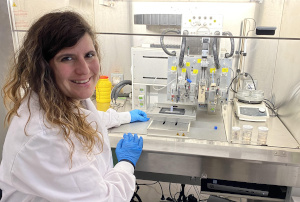CIC biomaGUNE, the Center for Cooperative Research in Biomaterials, has set up a new research group on Hybrid Biofunctional Materials which aims to obtain in vitro cell models using three-dimensional printing for the preclinical study of a range of cardiovascular and cardiopulmonary diseases and the testing of new drugs, for example. The group is working on arterial models using hybrid materials in a 3D printer: “We use organic material (polymers), cellular material (the cells themselves) and nanoparticles (to provide the model with physical stimuli),” as the Ikerbasque research fellow Dorleta Jimenez de Aberasturi, the group’s senior researcher, explained.
The current research goes beyond the classical two-dimensional in vitro plates used until now: “In nature, cells are not found in two dimensions, but are surrounded by multiple tissues with various functions. Now, we are trying to build all these layers using 3D printers in order to further disease research. To do this, we print the structures layer by layer to achieve the desired cell structure,” added the researcher. Once these models have been built, it is important to grow them because the cells need their nutrients, oxygen, etc. According to Dr Jimenez de Aberasturi, “it is important to achieve a suitable environment, so that the model is representative and real”.
“In one of the projects we are currently working on, we are completing all the cell layers of an artery in 3D. It is a cylindrical artery, stimulated to achieve the actual pulsations of a real artery,” explained the researcher. In this project they are working in collaboration with CIC biomaGUNE’s Molecular and Functional Biomarkers group, led by Ikerbasque professor Jesús Ruiz-Cabello, to create various flows or flow dynamics and to study the effect they have on the cells of the model using magnetic resonance imaging. The group is also working on the representation of alveolar membranes (the membranes of the concavities located at the end of the bronchi, where the oxygen exchange with the blood takes place), and is trying to represent the pulsations that occur in these alveoli during breathing.


Preclinical cardiovascular and cardiopulmonary research
“These models can be used to further the understanding of a range of cardiovascular or cardiopulmonary diseases. For example, the arterial models obtained can be used to better understand arteriosclerosis, a disease with many unknowns. Or they can be used to test or trial new drugs,” she explained.
Dorleta Jimenez de Aberasturi is delighted about the new challenges she is addressing: “It's great to be able to develop your own ideas. My curiosity as a researcher gives me the chance to do my bit for society. That is the hope of those of us who do biomaterials research.” The researcher's goal is to get these representative models “to be like the real thing, because if they could be used in medicine, we could test drugs or drive forward personalized medicine, for example by using a patient's cells to build a model and see what the response to different treatments is like. That would be lovely.”
About Dorleta Jimenez de Aberasturi
Dorleta Jimenez de Aberasturi has a PhD in Inorganic Chemistry from the University of the Basque Country (UPV/EHU) and Philipps University of Marburg (Germany), and joined CIC biomaGUNE in 2014 as a postdoctoral researcher in the research group of Ikerbasque professor Luis Liz-Marzán. In her research career she has been awarded a Marie Sklodowska-Curie grant (2016) and a Juan de la Cierva grant (2017), and has been on stays at the University of Michigan (USA) and at ETH Zürich (Switzerland). In 2019 she was recognized as an Ikerbasque research fellow, and has a project funded by the Spanish government.

